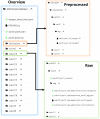EEG-based BCI Dataset of Semantic Concepts for Imagination and Perception Tasks
- PMID: 37322034
- PMCID: PMC10272218
- DOI: 10.1038/s41597-023-02287-9
EEG-based BCI Dataset of Semantic Concepts for Imagination and Perception Tasks
Abstract
Electroencephalography (EEG) is a widely-used neuroimaging technique in Brain Computer Interfaces (BCIs) due to its non-invasive nature, accessibility and high temporal resolution. A range of input representations has been explored for BCIs. The same semantic meaning can be conveyed in different representations, such as visual (orthographic and pictorial) and auditory (spoken words). These stimuli representations can be either imagined or perceived by the BCI user. In particular, there is a scarcity of existing open source EEG datasets for imagined visual content, and to our knowledge there are no open source EEG datasets for semantics captured through multiple sensory modalities for both perceived and imagined content. Here we present an open source multisensory imagination and perception dataset, with twelve participants, acquired with a 124 EEG channel system. The aim is for the dataset to be open for purposes such as BCI related decoding and for better understanding the neural mechanisms behind perception, imagination and across the sensory modalities when the semantic category is held constant.
© 2023. The Author(s).
Conflict of interest statement
The authors declare no competing interests.
Figures










Similar articles
-
A Spatio-Temporal Capsule Neural Network with Self-Correlation Routing for EEG Decoding of Semantic Concepts of Imagination and Perception Tasks.Sensors (Basel). 2024 Sep 15;24(18):5988. doi: 10.3390/s24185988. Sensors (Basel). 2024. PMID: 39338733 Free PMC article.
-
Chisco: An EEG-based BCI dataset for decoding of imagined speech.Sci Data. 2024 Nov 21;11(1):1265. doi: 10.1038/s41597-024-04114-1. Sci Data. 2024. PMID: 39572577 Free PMC article.
-
Simultaneous EEG and fNIRS recordings for semantic decoding of imagined animals and tools.Sci Data. 2025 Apr 12;12(1):613. doi: 10.1038/s41597-025-04967-0. Sci Data. 2025. PMID: 40221457 Free PMC article.
-
Eye-gaze independent EEG-based brain-computer interfaces for communication.J Neural Eng. 2012 Aug;9(4):045001. doi: 10.1088/1741-2560/9/4/045001. Epub 2012 Jul 25. J Neural Eng. 2012. PMID: 22831893 Review.
-
EEG-Based Brain-Computer Interfaces.Adv Exp Med Biol. 2019;1101:41-65. doi: 10.1007/978-981-13-2050-7_2. Adv Exp Med Biol. 2019. PMID: 31729671 Review.
Cited by
-
Covert cortical processing: a diagnosis in search of a definition.Neurosci Conscious. 2024 Feb 7;2024(1):niad026. doi: 10.1093/nc/niad026. eCollection 2024. Neurosci Conscious. 2024. PMID: 38327828 Free PMC article.
-
A Spatio-Temporal Capsule Neural Network with Self-Correlation Routing for EEG Decoding of Semantic Concepts of Imagination and Perception Tasks.Sensors (Basel). 2024 Sep 15;24(18):5988. doi: 10.3390/s24185988. Sensors (Basel). 2024. PMID: 39338733 Free PMC article.
-
An EEG Dataset of Neural Signatures in a Competitive Two-Player Game Encouraging Deceptive Behavior.Sci Data. 2024 Apr 16;11(1):389. doi: 10.1038/s41597-024-03234-y. Sci Data. 2024. PMID: 38627400 Free PMC article.
-
Chisco: An EEG-based BCI dataset for decoding of imagined speech.Sci Data. 2024 Nov 21;11(1):1265. doi: 10.1038/s41597-024-04114-1. Sci Data. 2024. PMID: 39572577 Free PMC article.
-
Brain-computer interfaces and human factors: the role of language and cultural differences-Still a missing gap?Front Hum Neurosci. 2024 Apr 11;18:1305445. doi: 10.3389/fnhum.2024.1305445. eCollection 2024. Front Hum Neurosci. 2024. PMID: 38665897 Free PMC article.
References
-
- Bakhshali MA, Khademi M, Ebrahimi-Moghadam A, Moghimi S. EEG signal classification of imagined speech based on riemannian distance of correntropy spectral density. Biomed. Signal Process. Control. 2020;59:101899. doi: 10.1016/j.bspc.2020.101899. - DOI
Publication types
MeSH terms
Grants and funding
- EP/S515279/1/RCUK | Engineering and Physical Sciences Research Council (EPSRC)
- EP/X001091/1/RCUK | Engineering and Physical Sciences Research Council (EPSRC)
- EP/T022523/1/RCUK | Engineering and Physical Sciences Research Council (EPSRC)
- AH/T004673/1/RCUK | Arts and Humanities Research Council (AHRC)
- AH/T004673/1/RCUK | Arts and Humanities Research Council (AHRC)
LinkOut - more resources
Full Text Sources

